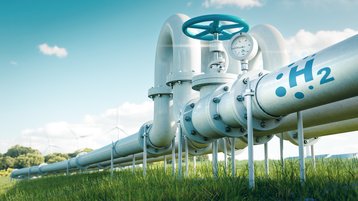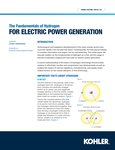As the data center landscape evolves rapidly, so does the interest, intrigue, and potential investment in clean and renewable energy sources. Hydrogen has emerged as a promising solution to address escalating demands for sustainable energy and efficient operations of data centers.
Understanding the basics of hydrogen is essential in analyzing the potential impact of various regulatory, manufacturing, and supply chain-related factors on its market adaptation as a source of clean energy.
At the ground level, there are three main reasons why the usage of hydrogen is of great interest in electric power generation:
- It’s a potent energy carrier.
- It’s a clean fuel.
- It’s abundantly available.
Let’s dive into each of these areas.
Hydrogen is a potent energy carrier
Hydrogen is an energy carrier, meaning it can temporarily store energy, which can be transported and later converted to other forms such as mechanical work (e.g., hydrogen-powered internal combustion engines) or electricity (e.g., hydrogen-powered fuel cells).
Additionally, hydrogen is a “potent” energy carrier because it has the highest energy content of any common fuel on a weight basis. One pound of hydrogen contains 54.44 Megajoules (MJ) of energy versus one pound of diesel, which includes 20.64 MJ, or one pound of gasoline, which has 20 MJ of energy. That means, on a weight basis, the energy content of hydrogen is almost three times that of diesel or gasoline, making it an extremely potent energy source.
Hydrogen is a clean fuel
When hydrogen combines with pure oxygen through the electrochemical process, it produces water and releases energy, i.e., electricity; thus, the process has no byproducts that are harmful to the environment. This environmentally-friendly attribute makes it an appealing option for various electricity generation and transportation applications.
Note that hydrogen burns clean only when combined with pure oxygen. When hydrogen burns with oxygen in the presence of air, other components in the air cause the production of oxides of nitrogen (NOx) as by-products.
Hydrogen is abundantly available
Hydrogen is everywhere on Earth. But it is found in a compound form. Although hydrogen is stable in its molecular form, the bond in the hydrogen molecule isn't that strong. That's why hydrogen does not exist naturally and needs to be extracted from various compounds found on Earth, such as:
- Liquid form: petroleum, water
- Gaseous form: natural gas of any methane-rich gas
- Solid form: coal, biomass (e.g., wood, manure, crops)
This leads to an important deduction that energy must be spent to extract hydrogen from its various compound forms. Interestingly, it takes more energy to produce (extract) hydrogen than it provides as an energy carrier. However, the benefits associated with its abundant availability, high energy content, energy storage attribute, and clean emission characteristics still make it a compelling choice for the data center industry in achieving clean energy goals.
Hydrogen production
Hydrogen can be produced (extracted from its compound form) using various processes. It is also important to note that not every hydrogen production process produces carbon-free emissions, but many do. Some of the methods used to produce hydrogen include:
- Biological Process - microorganisms such as bacteria and microalgae produce hydrogen through physical reactions using sunlight or organic matter.
- Electrolytic Process - electricity is used to split water into hydrogen and oxygen, a popular power-to-gas process in the commercial sector.
- Direct Solar Water-Splitting Process (Photolytic Process) - solar energy is used to split water into hydrogen and oxygen.
- Thermochemical Process - uses heat and chemical reactions to release hydrogen from organic materials such as fossil fuels and biomass.
Storing hydrogen
Although hydrogen has approximately three times the energy content of gasoline or diesel per unit weight, it is nearly 14.6 times lighter than air. Due to this very low volumetric efficiency of hydrogen, its storage tank for the same amount of energy as offered by other common fuels at room temperature would be disproportionately large.
Hence, the density of hydrogen needs to be increased to store it in a storage tank of viable size. Hydrogen can be stored in gaseous, liquid, or solid forms. In liquid form, hydrogen offers higher energy content in a smaller storage tank as compared with the storage in gaseous form.
Liquid hydrogen demands an extremely low temperature of -423.17 Deg F. Although hydrogen is non-toxic, its inflammable, odorless, colorless, and metal embrittling characteristics add more layers of complexities in its storage and transportation. Efforts are underway to tackle these difficulties.
Hydrogen in action
Two examples of technologies that use hydrogen to produce electricity are internal combustion (IC) engine generators and fuel cells. IC engines are typically categorized into two main types: compression ignition (CI) engines, such as diesel-fueled engines, and spark-ignited (SI) engines, like those powered by gasoline or gaseous fuels.
When these engines run on fossil fuels, they release exhaust containing harmful pollutants such as unburnt hydrocarbons (HC), carbon monoxide (CO), oxides of nitrogen (NOx), and particulate matter (PM). However, the combustion of pure hydrogen, known as a 100 percent hydrogen blend, in IC engines generates zero carbon emissions and moderate NOx emissions.
Hydrogen exhibits properties that make it more compatible with SI engines than CI engines. Moreover, since hydrogen lacks carbon molecules, blending with traditional fuels results in lower CO and CO2 emissions, presenting a promising pathway toward cleaner engine operation.
Transitioning to running IC engines solely on 100 percent hydrogen requires significant design modifications and pertinent engine derate.
Hydrogen in action: Fuel cells
Hydrogen-powered fuel cells are promising technologies that aid us in achieving net zero emission goals. Fuel cells, essentially electrochemical cells, utilize hydrogen and oxygen to produce electricity. The operating principle of a fuel cell is essentially the reverse of an electrolytic process, where electricity splits water molecules into hydrogen and oxygen.
Remember that electricity is generated when pure hydrogen fuels fuel cells with only heat and water vapor as byproducts. Additionally, specific fuel cells can operate on hydrogen-rich fuels, albeit with some carbon emissions depending on the fuel type used, alongside the typical byproducts of heat and water.
Hydrogen’s versatility and eco-friendly characteristics promise to combat climate change and move towards clean energy. Besides electric power generation, hydrogen has been a subject of interest in many other industries, such as transportation, food processing, petroleum refining, manufacturing, and many more. Specifically for the data center industry, the integration of hydrogen is vital.
We all recognize that further advancements in hydrogen-related technologies in the power generation segment are essential. This includes enhancing, restructuring, or transforming – if required- hydrogen use cases, supply chain, production techniques, storage, and transportation methods. The cost and the dimensional footprint of hydrogen-based power generation technologies must be significantly lowered.
Nonetheless, given its myriad advantages, the allure of hydrogen is undeniable. Its makeup as a clean energy source can revolutionize power generation systems. It offers an environmentally sustainable solution to meet the escalating energy demands placed on data centers, reducing their carbon footprint.





